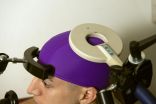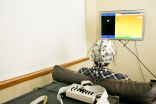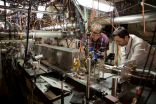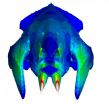(Press-News.org) Sometimes, words just complicate things. What if our brains could communicate directly with each other, bypassing the need for language?
University of Washington researchers have successfully replicated a direct brain-to-brain connection between pairs of people as part of a scientific study following the team's initial demonstration a year ago. In the newly published study, which involved six people, researchers were able to transmit the signals from one person's brain over the Internet and use these signals to control the hand motions of another person within a split second of sending that signal.
At the time of the first experiment in August 2013, the UW team was the first to demonstrate two human brains communicating in this way. The researchers then tested their brain-to-brain interface in a more comprehensive study, published Nov. 5 in the journal PLOS ONE.
"The new study brings our brain-to-brain interfacing paradigm from an initial demonstration to something that is closer to a deliverable technology," said co-author Andrea Stocco, a research assistant professor of psychology and a researcher at UW's Institute for Learning & Brain Sciences. "Now we have replicated our methods and know that they can work reliably with walk-in participants."
Collaborator Rajesh Rao, a UW associate professor of computer science and engineering, is the lead author on this work.
The research team combined two kinds of noninvasive instruments and fine-tuned software to connect two human brains in real time. The process is fairly straightforward. One participant is hooked to an electroencephalography machine that reads brain activity and sends electrical pulses via the Web to the second participant, who is wearing a swim cap with a transcranial magnetic stimulation coil placed near the part of the brain that controls hand movements.
Using this setup, one person can send a command to move the hand of the other by simply thinking about that hand movement.
The UW study involved three pairs of participants. Each pair included a sender and a receiver with different roles and constraints. They sat in separate buildings on campus about a half mile apart and were unable to interact with each other in any way – except for the link between their brains.
Each sender was in front of a computer game in which he or she had to defend a city by firing a cannon and intercepting rockets launched by a pirate ship. But because the senders could not physically interact with the game, the only way they could defend the city was by thinking about moving their hand to fire the cannon.
Across campus, each receiver sat wearing headphones in a dark room – with no ability to see the computer game – with the right hand positioned over the only touchpad that could actually fire the cannon. If the brain-to-brain interface was successful, the receiver's hand would twitch, pressing the touchpad and firing the cannon that was displayed on the sender's computer screen across campus.
Researchers found that accuracy varied among the pairs, ranging from 25 to 83 percent. Misses mostly were due to a sender failing to accurately execute the thought to send the "fire" command. The researchers also were able to quantify the exact amount of information that was transferred between the two brains.
Another research team from the company Starlab in Barcelona, Spain, recently published results in the same journal showing direct communication between two human brains, but that study only tested one sender brain instead of different pairs of study participants and was conducted offline instead of in real time over the Web.
Now, with a new $1 million grant from the W.M. Keck Foundation, the UW research team is taking the work a step further in an attempt to decode and transmit more complex brain processes.
With the new funding, the research team will expand the types of information that can be transferred from brain to brain, including more complex visual and psychological phenomena such as concepts, thoughts and rules.
They're also exploring how to influence brain waves that correspond with alertness or sleepiness. Eventually, for example, the brain of a sleepy airplane pilot dozing off at the controls could stimulate the copilot's brain to become more alert.
The project could also eventually lead to "brain tutoring," in which knowledge is transferred directly from the brain of a teacher to a student.
"Imagine someone who's a brilliant scientist but not a brilliant teacher. Complex knowledge is hard to explain – we're limited by language," said co-author Chantel Prat, a faculty member at the Institute for Learning & Brain Sciences and a UW assistant professor of psychology.
INFORMATION:
Other UW co-authors are Joseph Wu of computer science and engineering; Devapratim Sarma and Tiffany Youngquist of bioengineering; and Matthew Bryan, formerly of the UW.
The research published in PLOS ONE was initially funded by the U.S. Army Research Office and the UW, with additional support from the Keck Foundation.
For more information, contact Stocco at stocco@uw.edu or 206-685-8610, Rao at rao@cs.washington.edu or 206-685-9141 and Prat at csprat@uw.edu or 206-685-8610.
PLOS ONE paper: http://dx.plos.org/10.1371/journal.pone.0111332
Video of demonstration: http://youtu.be/xRsx5egJoYk
Information on future research: http://ilabs.washington.edu/i-labs-news/making-steps-toward-brain-brain-communication
Scientific American article by Rao and Stocco about possible uses of sending thoughts directly between brains.
Posted with video, photos: http://www.washington.edu/news/2014/11/05/uw-study-shows-direct-brain-interface-between-humans/
UW study shows direct brain interface between humans
2014-11-05
ELSE PRESS RELEASES FROM THIS DATE:
Pediatricians' communication with parents critical to overcoming obesity in Latino children
2014-11-05
DALLAS – November 5, 2014 – UT Southwestern Medical Center physician-researchers found that 1-in-5 parents of overweight Latino children is not directly told that the child is overweight. Furthermore, sometimes no discussion of weight occurred when a language barrier existed – a finding that signifies the challenges of reversing the rapidly rising rates of obesity in minority children. The study is published in the November edition of the journal Pediatrics.
In recent years, obesity has become a prevalent health concern for children of all races in the ...
Older men less likely to receive osteoporosis screening and treatment following a bone fracture
2014-11-05
ROSEMONT, Ill.—Osteoporosis, a common condition causing progressive bone loss and increased fracture risk, is primarily thought of as a disease affecting older women. And yet, up to one in four men over age 50 will break a bone due to osteoporosis. A study in the November 5 issue of the Journal of Bone & Joint Surgery (JBJS) found that men were three times less likely than women to undergo bone mass density (BMD) testing following a broken wrist (distal radius fracture) and seven times less likely to begin treatment for osteoporosis.
With an aging U.S. population, ...
Increase in ozone-destroying substances -- but Montreal Protocol on track
2014-11-05
Research from the University of Leeds and an international team of scientists has shown a recent increase in atmospheric hydrogen chloride (HCI), a substance linked to destruction of the ozone layer.
It was anticipated that there would be a decline in HCI under the Montreal Protocol, the international treaty designed to protect the ozone layer by phasing out the production of ozone-depleting substances.
Dr Emmanuel Mahieu from the University of Liège in Belgium, who led the research, explained: "It's important to say that the Montreal Protocol is still on track, ...
First amphibious ichthyosaur discovered, filling evolutionary gap
2014-11-05
The first fossil of an amphibious ichthyosaur has been discovered in China by a team led by researchers at the University of California, Davis. The discovery is the first to link the dolphin-like ichthyosaur to its terrestrial ancestors, filling a gap in the fossil record. The fossil is described in a paper published in advance online Nov. 5 in the journal Nature.
The fossil represents a missing stage in the evolution of ichthyosaurs, marine reptiles from the Age of Dinosaurs about 250 million years ago. Until now, there were no fossils marking their transition from land ...
Coexist or perish, new wildfire analysis says
2014-11-05
Many fire scientists have tried to get Smokey the Bear to hang up his "prevention" motto in favor of tools like thinning and prescribed burns, which can manage the severity of wildfires while allowing them to play their natural role in certain ecosystems.
But a new international research review led by the University of California, Berkeley, says the debate over fuel-reduction techniques is only a small part of a much larger fire problem that will make society increasingly vulnerable to catastrophic losses unless it changes its fundamental approach from fighting fire ...
Osteoporosis, not just a woman's disease
2014-11-05
BOSTON – Each year nearly two million Americans suffer osteoporosis-related fractures, and as the population ages that number is expected to increase dramatically, placing a major burden on the health care system. While osteoporosis prevention and treatment efforts have historically been focused on post-menopausal women, a new study from Beth Israel Deaconess Medical Center (BIDMC) suggests that critical opportunities are being lost by not focusing more attention on bone loss and fracture risk in older men.
"Given that the prevalence of fragility fractures among ...
Genesis of genitalia
2014-11-05
When it comes to genitalia, nature enjoys variety. Snakes and lizards have two. Birds and people have one. And while the former group's paired structures are located somewhat at the level of the limbs, ours, and the birds', appear a bit further down. In fact, snake and lizard genitalia are derived from tissue that gives rise to hind legs, while mammalian genitalia are derived from the tail bud. But despite such noteworthy contrasts, these structures are functionally analogous and express similar genes.
How do these equivalent structures arise from different starting ...
Researchers hit milestone in accelerating particles with plasma
2014-11-05
Scientists from the Department of Energy's SLAC National Accelerator Laboratory and the University of California, Los Angeles have shown that a promising technique for accelerating electrons on waves of plasma is efficient enough to power a new generation of shorter, more economical accelerators. This could greatly expand their use in areas such as medicine, national security, industry and high-energy physics research.
This achievement is a milestone in demonstrating the practicality of plasma wakefield acceleration, a technique in which electrons gain energy by essentially ...
Madagascar: Fossil skull analysis offers clue to mammals' evolution
2014-11-05
AMHERST, Mass. – The surprise discovery of the fossilized skull of a 66- to 70-million-year-old, groundhog-like creature on Madagascar has led to new analyses of the lifestyle of the largest known mammal of its time by a team of specialists including biologist Elizabeth Dumont at the University of Massachusetts Amherst, an expert in jaw structure and bite mechanics.
The skull of this animal, named Vintana sertichi, was found in a geological formation deposited when a great variety of dinosaurs roamed the earth. With a skull that is almost five inches (125 mm) ...
New global wildfire analysis indicates humans need to coexist and adapt
2014-11-05
A new study led by the University of California, Berkeley and involving the University of Colorado Boulder indicates the current response to wildfires around the world—aggressively fighting them—is not making society less vulnerable to such events.
The study suggests the key is to treat fires like other natural hazards—including earthquakes, severe storms and flooding—by learning to coexist, adapt and identify vulnerabilities. The new study indicates government-sponsored firefighting and land management policies may actually encourage development ...








